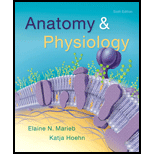
Case summary:
The given case is of a patient named Mr. D.A., who is 49-years-old and is the driver of a bus. He met with an accident and was admitted to the emergency room with blunt trauma. He complained of chest, left upper quadrant, and epigastriapain. The examination revealed low blood pressure and mild tachycardia. Later on, the blood pressure fell down and the heart rate increased with muffled heart sound. The patient complained of the pain radiating to the back.
Characters in the case:
Donald Ayers, a 49-year-old male, and paramedics.
Adequate information:
The results of the examination revealed that the heat beat was 110 bpm and the blood pressure was 105/75 mm Hg. After a few minutes, the blood pressure increased and the heart rate also increased.
To determine:
The reason behind the bulging of the veins in Mr. Ayer's neck.
Want to see the full answer?
Check out a sample textbook solution
Chapter 17 Solutions
Anatomy & Physiology (6th Edition)
- To review: (a) The term "Transfusion reaction". (b) The possible consequences of transfusion reaction.arrow_forwardWhich heart activity correlated with the highlighted portion of the EKG in this image? A) atrial depolarization B) right heart depolarization C) ventricle depolarization D) depolarizationarrow_forwardIs a thrombus in the external carotid life-threatening? Why or why not?arrow_forward
- A patient with a suspected myocardial infarction is brought to the emergency department. Which diagnostic test is most appropriate for confirming the diagnosis? A) Echocardiogram B) Troponin level C) Electrocardiogram (ECG) D) Chest X-rayarrow_forwardAnother patient had an abnormal heart sound that indicated a stenotic valve. Define this condition, and contrast it with an incompetent heart valve.arrow_forwardWhy are the tendinous cords required for the proper functioning of the AV valves?arrow_forward
- Which of the following is most likely to be present on the resting EKG recording of a patient with AV node damage?A) An R-R interval of 0.52 seconds at rest.B) A P-R interval of 0.28 seconds at rest.C)An inverted T waveD) Normal sinus rhythmarrow_forwardA patient in the ICU is receiving continuous electrocardiogram (ECG) monitoring. The nurse identifies which dysrhythmia as potentially life-threatening and requiring immediate intervention? a) Sinus bradycardia b) Atrial fibrillation c) Premature ventricular contractions (PVCs) d) Ventricular tachycardia (VT)arrow_forwardWhat is a pulse? List the locations on the body where thepulse can easily be detected.arrow_forward
- Which of the following forms of shock occurs as a result of expansion of the vascular compartment? Question 17 options: a) Cardiogenic b) Neurogenic c) Hypovolemic d) Obstructivearrow_forwardWhat is tachycardia?arrow_forwardMrs. Peterson, who is 76 years old, complained of palpitations and shortness of breath. Noticing that her pulse was irregular, the doctor asked her to get an ECG done. When the ECG report came back, the doctor prescribed some anticoagulants for Mrs. Peterson. Why was she asked to take anticoagulants? What do you think she was suffering from?arrow_forward
